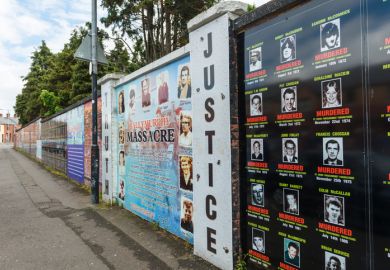Eric Homberger's book treats four distinct but parallel elements of mid- to late-19th-century New York. There is the dire poverty of its immigrant classes; the life and times of a prosperous 19th-century abortionist; the Tweed Ring and organised civic corruption; and the impulse behind the creation of Central Park by Frederick Law Olmsted.
These four stories do not constitute a complete history of New York during this period, but at their best they provide a ghoulishly fascinating survey of the city's more extraordinary negative aspects, counterbalanced by the birth of Central Park.
Tales of New York's urban poor probably do not differ much from those of many other cities in Europe and the United States. Special to New York, however, was the flood of immigration after the end of the Civil War in 1865. One half of the population was then foreign to the city, and in some parts English was hardly spoken. Conditions in The Tombs prison, to which the poor were sent, were harrowing. The eradication of the New York slums was difficult, and the effort was not rewarded until the beginning of this century.
Homberger's study of the abortionist Madame Restell and her extraordinary rise to wealth is compelling, especially in the light of supposed 19th-century moral values. The study begins with descriptions of pre-natal examinations "conducted with the female fully dressed, and the doctor carefully averting his eyes. Etiquette prescribed certain topics of conversation during the examination . . ." Despite the teachings of the Catholic church, most women of the age sought abortions when they thought them necessary, "and the public seems to have ignored the subject". But after 1879, with the enactment of legislation to ban abortions, abortionists performed their trade at their peril.
The medical world in which 19th-century abortion mills operated was not an attractive or sanitised one. Homberger portrays several characters from within its ranks but focuses on Restell, its most successful practitioner.
Despite periods incarcerated in The Tombs and some financial struggle, she built a great fortune on pills (for the most part useless) and surgery, which enabled her to speculate in property - before ending her life tragically in suicide.
Abortionists were, it seems, well beyond the pale of social acceptability, and even in her dotage the ugly association pursued Madame Restell to her end; it was a final period in The Tombs that pushed her over the edge.
The narrative about the Tweed Ring covers similar territory, and by now many readers will need a break from such a depressing picture of human nature, and New York, at its lowest. It is with a sense of relief and hope that one turns to the last chapter, on Central Park.
Olmsted was the hero behind the park, who provided what Restell and the others discussed by Homberger did not: open space, civic values and a brilliant plan to rescue the masses from cramped conditions and degradation. But the chapter is more about the beginnings of the park, and the squabbles to decide where it would be and who would pay for and benefit from its construction, than about its actual construction.
Nothing came easily to New York, we learn: several plans and influential players emerged before the final outcome was reached. The would-be parkland was then home to "200 shanties, barns, stables and bone factories". The land had been quarried for decades, it had a disused mill and a blocked stream on its west side at 74th Sreet and "marshy land . . . thickly grown with tangled vine, making foot passage virtually impossible".
However, once its central position was determined upon, then the great democratic personality of Olmsted was poised to leave his stamp on the park's design. The commissioners called for "four east-west crossings, a parade ground of 20 to 40 acres, three playgrounds of three to ten acres each, a site for an exhibition or concert hall, a site for an ornamental fountain, a site for a prospect tower, a flower garden of two to three acres, and a place which could be flooded for skating in the winter". Most of the "wish list" was built, with only minor adaptations.
Scenes From The Life Of A City covers original ground in its examination of abortion. The other subjects have been dealt with elsewhere more extensively, though perhaps more drily. The narrative is at times depressing but the book illustrates very well the difficulties of providing social services in one of the world's great urban centres.
Christopher W. London is an art and architectural historian who divides his time between New York and London.
Scenes from the Life of a City: Corruption and Conscience in Old New York
Author - Eric Homberger
ISBN - 0 300 06041 6
Publisher - Yale University Press
Price - £20.00
Pages - 293
Register to continue
Why register?
- Registration is free and only takes a moment
- Once registered, you can read 3 articles a month
- Sign up for our newsletter
Subscribe
Or subscribe for unlimited access to:
- Unlimited access to news, views, insights & reviews
- Digital editions
- Digital access to THE’s university and college rankings analysis
Already registered or a current subscriber? Login



